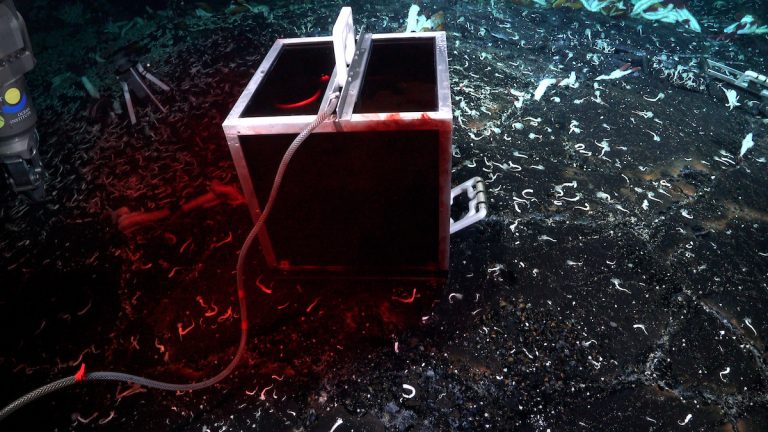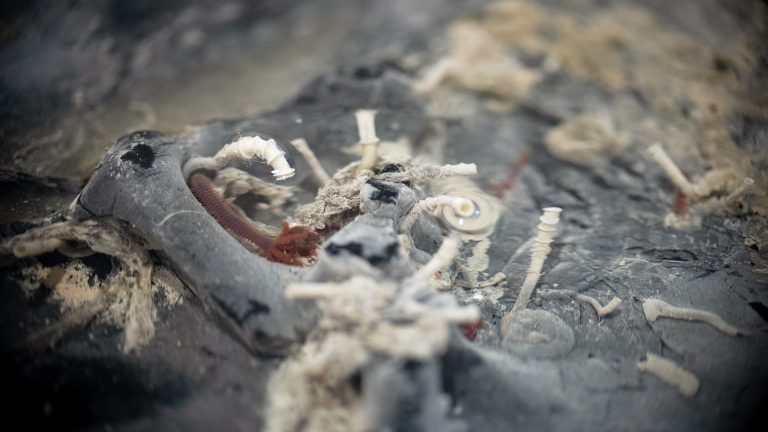Dr. Monika Bright and International Team Discover a New Dimension to Hydrothermal Vents
Dr. Monika Bright had a singular goal when she stepped onto the massive aft deck of R/V Falkor (too)—find evidence that giant tubeworm larvae travel beneath the seafloor to colonize new vent fields. Near the end of her distinguished career as a professor at the University of Vienna studying the three-meter-long worms and their symbiotic bacteria, Monika had waited several years to lead this particular expedition, the first on which she would hold the role of “Chief Scientist.”

Armed with a new sampling system she referred to as the “Mesh Box Staining Gadget” and an international team from Austria, the US, Germany, France, Costa Rica, the Netherlands, and Slovenia, Monika felt prepared to begin her quest to answer the question that had been nagging her for a decade. Do hydrothermal vent animal larvae travel beneath the seafloor? She was not expecting to find an entirely new ecosystem.
To answer the question, the team headed to a well-studied underwater volcano known as 9°50`N, a location on the East Pacific Rise where hydrothermal systems have been studied for decades. 9°50`N is where scientists described ecosystem succession after a volcano erupts and paves over a hydrothermal vent, determining which animals are the first to arrive and build the hydrothermal vent community.
The volcano is covered in black smoker vents and diffuse low-temperature vents, spewing liquid ranging from 75 to 250 degrees Celsius in temperature. Numerous cracks and crevices are peppered over pillow basalt—– a geologic formation where lava cools into globular formations on the seafloor. Giant tubeworms known as Riftia wrap around the vents while cusk eels tangle themselves amongst the worms. Occasionally, a Vulcanoctopus swims out into the open.

Upon reaching the study site, The Underworld of Hydrothermal Vents team began setting up their experiments as planned. The ROV pilots would clear an area above a vent crack of all animals and obstacles and then lay down a thick adhesive to glue the boxes down. Once the mesh box was in place, another solid box was placed over it to contain whatever came into the box from under the seafloor. The pilots then filled the two boxes with an environmentally harmless red dye, resulting in the entire science team and crew fondly calling the experiment “the blood boxes.”
The plan was to remove both the solid and mesh boxes after seven days and collect what had assembled within them. The red dye would stain the larvae already in the box when the experiment was placed, while new animals and larvae that emerged through the crack in the seafloor would be free of any red staining.
Yet, after five days, all the experiments had filled with a thick bacterial mat that was choking whatever life had traveled into them. The science team was excited to see how quickly the bacteria grew and also recognized the boxes had to be removed faster than the intended seven days.
Resigned that the experiment was not working as planned, (a common experience in all scientific disciplines), Monika and her team began to remove the boxes. Curious to see if it was possible to view what lay underneath the crust, the team asked the scientists if they could pick up the rock where the boxes had been placed. At first, the ROV pilots were unsure if this was possible, as they had never before removed cemented seafloor. Determined to aid the disappointed scientists, the ROV pilots had a lightbulb moment and suggested bringing a pry bar down to the vent field. A simple pry bar was all they needed for a groundbreaking scientific discovery.

The first piece of removed crust revealed baby tubeworms living below the Earth’s surface. As more crust was pried and flipped, more species were found beneath the seafloor living in the vent fluid. In arguably the most exciting moment, the scientists found full-grown giant tubeworms living in a cavity of the Earth’s crust. An ecosystem just below another ecosystem. And strong evidence that tubeworm larvae very likely travel below the seafloor, through vent fluid, to colonize new habitats. While scientists have known for a while that microbes live underneath hydrothermal vents, this is the first evidence that complex organisms also live and build ecosystems under vents.
The discovery of animals beneath the seafloor contributes more questions than it does answers to the realm of hydrothermal vent science. How far can larvae travel below the subseafloor? How long do they live in this environment? How do they withstand the low-oxygen conditions? While Dr. Bright looks towards retirement in the next few years, she leaves behind a new cohort of scientists eager to answer these questions.
Dr. Laura Sanchez Examines Distribution of Microplastics in the Water Column
In early August, National Geographic Explorer Dr. Laura Simon Sanchez and a small team from Aalborg University, Sweden, examined the sinking behavior of microplastics in the water column. The team filtered over 50,000 liters of water off the coast of Panama in order to collect enough data for their research. Watch the video below to learn more.
Upcoming Expeditions – The Galápagos and Beyond
September/October: Vertical Reefs of the Galápagos
The Galápagos Islands are home to a dazzling array of cold-water corals. While they are understudied compared to the shallow-water corals, a subset of these deep-dwelling animals is even more shrouded in mystery—cold-water corals living on cliffs. The depth and inaccessibility of vertical corals to ship-based sensors present significant hurdles to studying these creatures. Chief Scientist Dr. Katleen Robert, Memorial University, and her multidisciplinary team will overcome these challenges to map and characterize this extraordinary ecosystem while defining the environmental drivers that contribute to the formation of these reefs. To help study the ecosystem, the team will deploy a number of advanced technologies, including a laser scanner that will create an ultra-high resolution three-dimensional reconstruction of cold-water corals living on cliffs.
October/November: Ultra Fine-Scale Seafloor Mapping
Seafloor mapping is integral to oceanographic research. Bathymetric data illustrate the seafloor’s depth, contours, and physical features, and it is often the first essential step in planning a successful submersible operation. A potential ground-breaking technology is on the horizon for seafloor mapping, and it will be tested during this expedition. Chief Scientist Dr. John Jamieson, Memorial University of Newfoundland, and his team will explore the capabilities of a sonar system new to scientific seafloor mapping: Interferometric Synthetic Aperture Sonar (InSAS). This technology combines bathymetric data with acoustic imagery (“photographs” using sound instead of light) and is capable of unmatched resolutions fine enough to depict individual animals dwelling in the depths. Jamieson and his team will put InSAS through its paces on hydrothermal vent fields of the Eastern Galapágos Spreading Center as they assess its potential as a revolutionary seafloor mapping tool.
We invite you to share the newsletter with your friends and encourage them to subscribe, so they do not miss our first look at Schmidt Ocean Institute’s activities.
Chapter 5 Newsletter – 2023 • Menu
Subscribe to our quarterly newsletter
